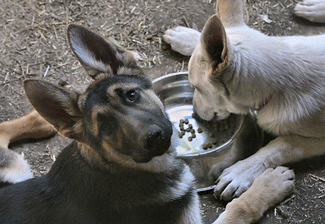
Charlie and Gretchen sharing supper. CC Indiana Stan
By Gary Richter, DVM, Holistic Veterinary Care and Rehabilitation Center, Oakland
As an integrative veterinarian, I frequently encounter questions about the best food to feed a dog. My answer depends factors including age, breed, current state of health and lifestyle. One generalization can be made: the closer we get our pets to eating a fresh, whole-food diet, the better their health tends to be.
Multiple forms of foods are available to offer our pets. Nutritionally speaking, some are better than others. Remember, some dogs will do better on certain foods than others.
FRESH FOOD DIETS: These diets can be either raw or lightly cooked and may be purchased prepared (fresh or frozen) or made at home using a balanced recipe.
– Pros: Fresh food contains excellent nutrition and high-moisture content with minimal artificial ingredients, preservatives, etc. It preserves micronutrients and enzymes that may be lost in other food formats. Many pets with chronic inflammatory conditions, such as allergies or inflammatory bowel disease, fare better on fresh-food diets. When made at home, fresh-food diets can be reasonably cost effective.
– Cons: Fresh food is perishable and requires frequent preparation and/or significant freezer space for storage. Appropriate precautions should be taken when handling and feeding raw meat. Pre-made, raw-diet foods purchased in stores are expensive.
LOW TEMPERATURE PROCESSED FOODS:: These diets are generally freeze-dried versions of fresh, whole-food diets. They can be purchased at most pet stores.
– Pros: Freeze-dried diets retain many of the benefits of fresh, raw diets. Since water is added before feeding, moisture content is controlled. This helps ensure that dogs are getting enough water. These diets tend to be made with very high-quality ingredients and also have a long shelf life at room temperature, which can be a big plus.
– Cons: Even though the diet is freeze-dried, consideration for cross-contamination to humans should be a caution. Cost can be an issue for larger dogs.
CANNED DIETS: Canned dog food ranges from super-premium to very low quality. It is important to read ingredient labels and know what you are buying.
– Pros: Canned diets have a very long shelf life, making them convenient. High moisture content helps provide extra water in the diet. Canned foods are also lower in carbohydrates than kibble and thus may help prevent obesity and inflammation.
– Cons: Canned foods are by necessity processed at very high temperature, as the food within the can must be sterilized before the can is sealed. The result may be loss of beneficial micronutrients and enzymes. In addition, there have been concerns about metals or plastics leaching into the food.
DRY FOOD: Kibble is by far the most popular form of food due to its relatively low cost and long shelf life. The range of ingredient quality in kibble is as varied as that in canned diets.
– Pros: You can’t beat the convenience, and it is inexpensive relative to other food formats.
– Cons: Kibble manufacturing is a high-temperature process that may affect nutrient profile. Whether grain-free or not, kibble is high in carbohydrates. High-carbohydrate diets can lead to weight gain and chronic inflammation. The very low moisture content in kibble may also lead to pets (particularly cats) having chronic, mild dehydration. This in turn may affect health in the long term.







